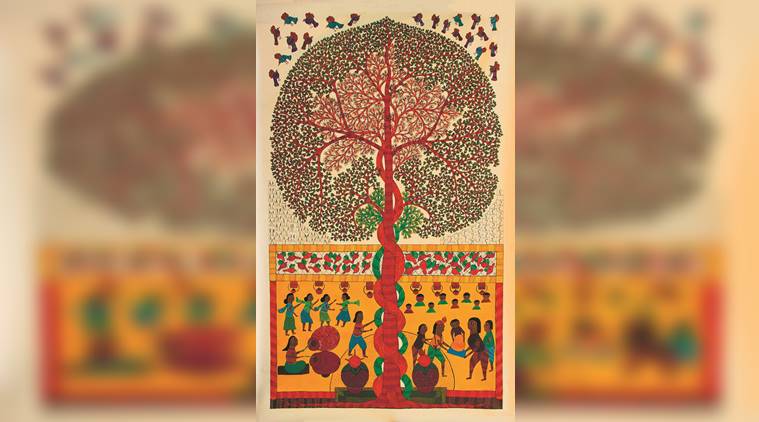Folk Art to the Fore
An exhibition hopes to put spotlight on the folk artists of India

A work by Suresh Kumar Dhurve depicting Govardhan puja in a Gondi village
Folk deity Raja Salhesh tries to run away from a cluster of women who is in love with him and wish to marry him. He is then magically turned into a sheep and tied to a tree. Soon, his wife goes searching for him and tells her brother-in-law, Motiram, who then goes looking for him, while riding on a horse like a valiant warrior. The dying oral history of the adventures of Raja Salhesh continues to be sung as songs by the Paswan community in the Mithilanchal region of Bihar. The tale has been painted in Madhubani by artist Ganesh Paswan. Mounted at Delhi’s Bikaner House, his painting titled Scene of the legend of folk deity Raja Salhesh is alongside Bengal’s vibrant traditional folk art Patachitra and Gond art from Madhya Pradesh in an exhibition titled ‘Swayambhuva’.
The works of over 36 regional artists from these three regions have been brought together by Delhi-based initiative Lokatma to shed light on how rural arts need monetary returns and patronage for survival. These canvases are priced between Rs 11 and three lakh. Lokatma’s founder Gauri Varma says, “People assume that folk art should be very cheap in India, say for Rs 500, which is a tragedy. We are so used to seeing it around us on a commercial scale that we fail to realise that there are only a few folk artist clusters left. So much branding has been done for contemporary and modern art; if these artists receive a fraction of that, it will make a huge difference. Even a completely new modern artist, who is not established, starts his works at Rs 50,000. So the question arises around the politics of who paints and who decides what art is.”
Amid almost 60 works is artist Suresh Kumar Dhurve’s Gond painting depicting the celebrations of Govardhan Puja underway in a Gondi village and the importance of trees in the lives of people there. Villagers dancing to the thundering beats of the dholak, are seen hovering around three intertwined trees, including the mahua tree, considered sacred to the Gonds, since they believe their gods reside in them. They are also seen decorating the space with diyas to ring in the carnival in the evening. In another black and white canvas by Dhurve, farmers are seen eating their midday meal under a mahua tree after ploughing their fields.
Among the Bengali pata paintings that have narrated folklore and Hindu mythology, including the Ramayana and the Mahabharata for generations, are long scrolls that highlight the marvels of the artform. For instance, replete in earthy tones of brown, The Journey of Behula narrates the heroic tale of the devoted wife Behula, culled from the treasures of Bengali literature. Handpicked from one of the earliest epics, Manasamangal Kavya, it is a visual narration of how Behula succeeds in winning back the life of her husband.
Talking about the aim of her initiative, which she calls “boutique of folk art”, Varma says that very often, however masterly these works are, they largely remain hidden because of the location of these rural artisans and the fact that they are not economically well off. “With the urge to push for quick paintings and commercialisation, a lot of the old traditions, motifs and quality of these art forms are fading. Several melas and NGOs help create an atmosphere for folk art but the rates they get are very low. The problem with mass commercialisation is that the quality of art suffers because they don’t get the prices. Now these works can either be part of a bulk segment, or a curated segment where one can look at folk art entirely, such as this.”
The exhibition is on at Bikaner House, Pandara Road, till July 15
For all the latest Lifestyle News, download Indian Express App






















No hay comentarios:
Publicar un comentario